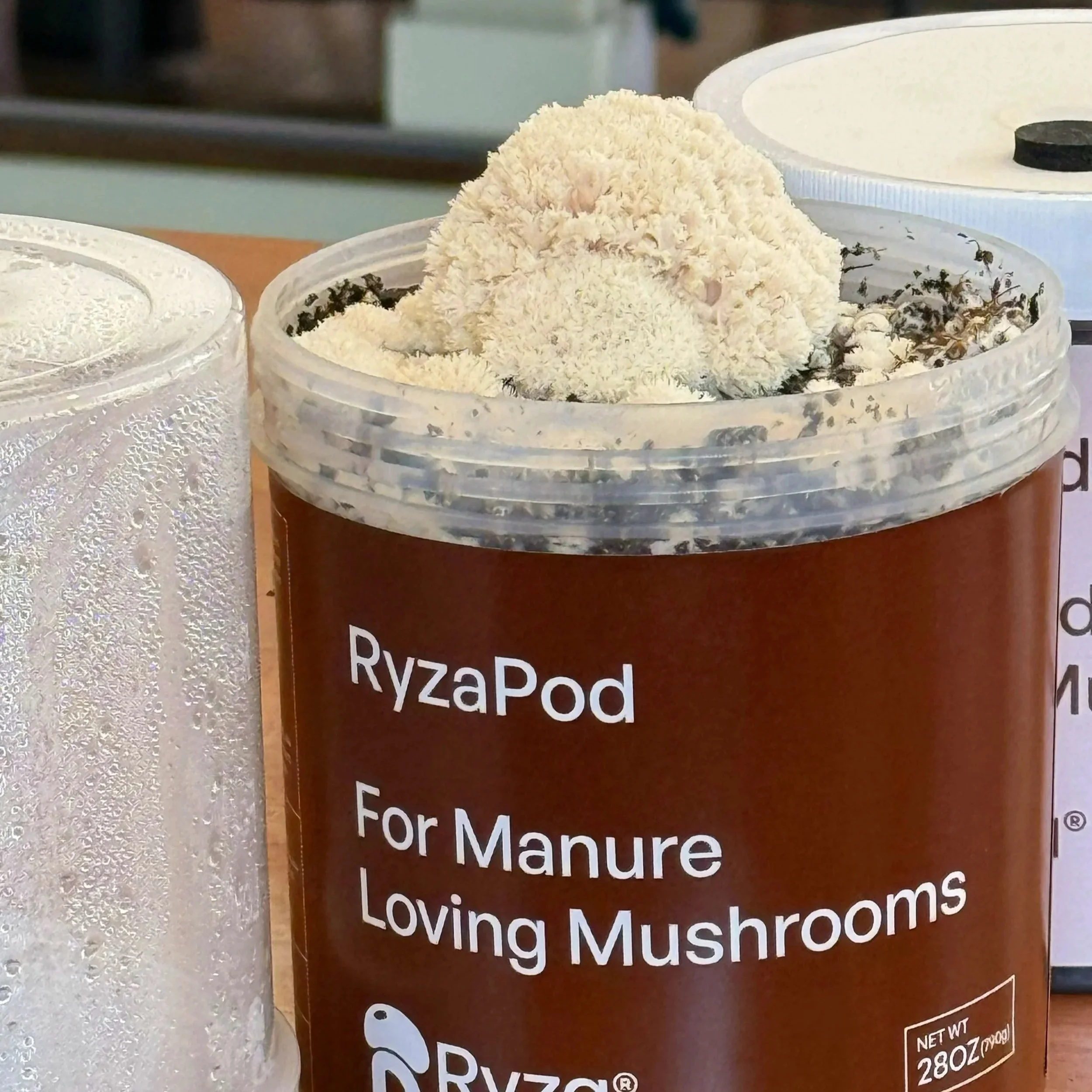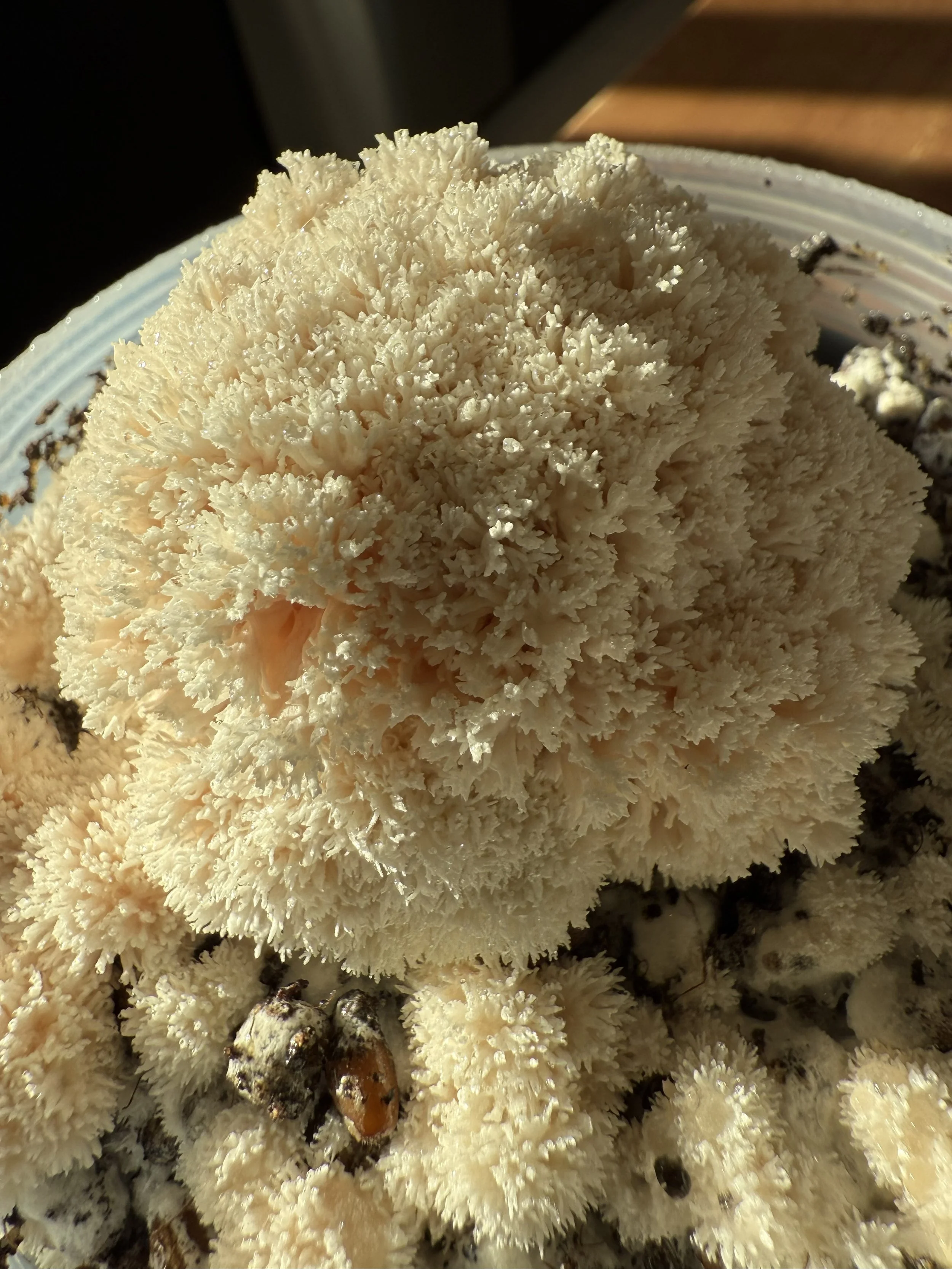How to Grow Lion's Mane Mushrooms at Home for Beginners: Easy Step-by-Step Guide
Lion’s Mane is a fun, easy, and fast mushroom to grow in our flagship mushroom grow kit, RyzaPods.
If you're new to mushroom cultivation and want to learn how to grow lion's mane mushrooms at home, this guide is for you. Lion's mane mushrooms (Hericium erinaceus) stand out with their unique, shaggy white appearance, often compared to a lion's mane or even crab meat in texture. This fungi is considered both a gourmet and medicinal mushroom, and is popular among home growers for their distinctive look and culinary uses. In this detailed tutorial, we'll show you how to grow lion's mane mushrooms using our user-friendly RyzaPods system. Ideal for beginners, RyzaPods make the process straightforward, helping you achieve fresh harvests in 4-6 weeks without advanced equipment.
Why lion's mane? This variety is a favorite for its visual appeal and versatility in recipes. With RyzaPods, you avoid common pitfalls of DIY methods like traditional grow bags, making it accessible even if you've had failures before. Let's dive in!
What Are Lion's Mane Mushrooms?
Lion's mane mushrooms are an edible fungus commonly found in the wild on hardwood trees such as oak or beech across North America, Europe, and Asia. They feature long, cascading white spines that create a fluffy, mane-like structure, setting them apart from more common mushrooms like buttons or portobellos.
In mycology terms, lion's mane is a saprotrophic species, thriving by breaking down dead wood. Lion’s mane will devour almost anything, and will grow in both our Manure Loving and Wood Loving RyzaPods. This characteristic makes it well-suited for indoor cultivation on enriched hardwood substrates, which our RyzaPods provide in a convenient, pre-prepared form.
Why Grow Lion's Mane Mushrooms at Home?
Growing lion's mane mushrooms at home lets you enjoy fresh, high-quality produce that's often expensive or unavailable in stores. It's a satisfying hobby that turns a simple setup into a productive mini-farm right in your kitchen. For beginners, it introduces the basics of mycology in a hands-on way.
Unlike outdoor methods like log inoculation, which can take months, indoor kits like RyzaPods deliver faster results with less effort. Skip the need for sterilization tools or large spaces—our all-in-one pods reduce risks and simplify the experience compared to standard grow bags.
Best Materials for Growing Lion's Mane Mushrooms at Home
To make growing lion's mane mushrooms easy, gather these essentials:
RyzaPods (4-Pack for Starters): These pre-sterilized grow kits are filled with a nutrient-optimized enriched substrate tailored for lion's mane. Expect yields of up to 30g dry (around 150g fresh) per pod with over multiple harvests or flushes. Wood or Manure Lover RyzaPods will work for Lion’s Mane, but Wood Lovers tend to work a little better for this Wood-loving species.
Lion's Mane Inoculant: Opt for liquid culture syringes for quicker results over spores. Our guide on How to Find Quality Mushroom Spores and Liquid Cultures offers tips on reliable sources.
Fine Mist Sprayer: Key for humidity control without excess water. Our fine mist sprayer provides even coverage.
Optional Extras: Gloves for mess-free harvesting, and a dedicated workspace. No specialized lighting required—just indirect ambient light.
Starting costs are low, typically under $70. Visit our shop to stock up on RyzaPods and accessories.
Step-by-Step Guide: How to Grow Lion's Mane Mushrooms at Home
See an overview of this grow on YouTube Shorts.
Using RyzaPods, the process breaks down into inoculation, colonization, fruiting, and harvesting. This beginner-friendly method minimizes complications. The below video shows many of the steps to grow lion’s mane in the RyzaPod mushroom grow kit.
Step 1: Preparation and Inoculation for Lion's Mane Mushrooms
Begin in a sanitized space to prevent issues.
Place your RyzaPods on a clean workspace, like a kitchen counter
Agitate the liquid culture syringe to mix evenly.
Use a sterile needle and inject ~5cc/5mL through each pod's port.
This quick step sets everything in motion. See the video above for a clear view of inoculation.
Link to our Spores vs. Liquid Cultures: What's the Difference? for more on choosing inoculants.
Step 2: Colonization Phase for Growing Lion's Mane
Store inoculated pods in a dark, warm location (70-75°F/21-24°C), away from light and air currents. We like the cabinet above the fridge because it fits all these criteria
In 1-2 weeks, white mycelium will colonize the substrate, forming a web-like network.
Once mycelium appears, give a vigorous shake to the RyzaPods for 30 seconds or so. RyzaPods contain a steel shaker ball that helps spread mycelium around for faster colonization.
Inspect periodically for uniform progress, watching for any off-colors indicating problems.
Lions mane is a fast colonizer - often taking only 3 weeks or so to completely colonize the RyzaPod, but it can take as long as 4.
Step 3: Initiating Fruiting and Pinning for Lion's Mane Mushrooms
When the substrate is fully white, transition to fruiting.
Relocate to a cooler area if possible (65°F/18°C) with indirect light, such as near a window. Room temperature often works fine for Lions Mane.
Use the humidity dome and lightly mist 2-3 times daily for 85-95% humidity.
Pins emerge as small white protrusions in 3-7 days.
Step 4: Growing and Misting Lion's Mane Mushrooms
Maintain light misting as pins develop into spiny clusters.
Full growth occurs in 7-14 days, with rapid expansion.
Fan occasionally for air circulation to avoid buildup.
See our guide on ideal fruiting conditions.
Step 5: Harvesting Homegrown Lion's Mane Mushrooms
It’s time to harvest when the Lion’s Mane reaches about half of the height of the humidity dome or as rapid growth declines. The mane can be gently peeled from the base substrate.
Per pod yield: 100-200g fresh per flush.
Refrigerate fresh or dry for storage. We like to use Colander Tek for drying our mushrooms without a dehydrator.
Rehydrate the substrate for follow on flushes use a heavy misting or the dunking technique. Additional flushes in 1-2 weeks.
Common Issues When Growing Lion's Mane Mushrooms at Home
Challenges can arise, but they're fixable:
Delayed Pinning: Often from insufficient humidity or warmth. Boost misting and adjust temperature.
Contamination Signs (e.g., Mold): Due to unclean handling - always wash hands before directly handling the mushrooms. Dispose and retry—RyzaPods' sterilization helps prevent this.
Abnormal Growth (Stretched or Discolored): From poor air or over-humidity. Enhance ventilation and reduce misting.
Slow Progress: Low temperatures; keep at 70-75°F. Or refresh inoculant.
Dry Substrate: Increase misting or add a humidity enclosure.
More advice in Home Mycology Equipment: What Do You Really Need?
Easy Recipes Using Homegrown Lion's Mane Mushrooms
Lion's mane's firm, meaty texture shines in cooking, mimicking seafood.
Lion's Mane "Crab" Cakes: Shred 200g, combine with breadcrumbs, egg substitute if vegan, seasoning, and veggies. Pan-fry into patties.
Seared Lion's Mane Steaks: Cut thick slices, cook in oil with herbs for a simple dish.
Lion's Mane Stir-Fry: Sauté chopped pieces with vegetables and sauce for a fast meal.
These ideas showcase its subtle flavor. Tag us on social with your recipes!
FAQ: Growing Lion's Mane Mushrooms at Home
How long to grow lion's mane mushrooms at home? Typically 4-6 weeks total.
Do lion's mane mushrooms need light? Indirect only—no grow lights. Read How Much Light Do Mushrooms Need?.
Can I grow lion's mane outdoors? Possible on logs, but kits are better for indoor beginners.
Are lion's mane mushrooms edible? Yes, when cooked properly.
Best substrate for lion's mane? Hardwood mixes, like in RyzaPods.
Final Thoughts: Start Growing Lion's Mane Mushrooms at Home Today
Mastering how to grow lion's mane mushrooms at home is achievable and enjoyable with the right tools. RyzaPods simplify it for beginners, leading to impressive results. Ready? Get your RyzaPods and begin—fast, discreet shipping. Explore more in Ryza Knowledge in our Mycopedia.
Happy cultivating!


